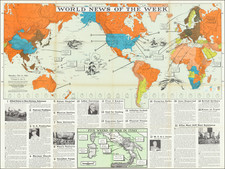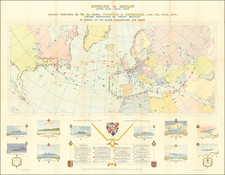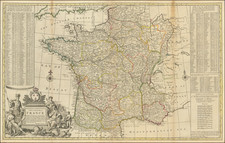Rare top-secret map of Carentan, prepared for D-Day.
A rare “Top Secret” map depicting the area around Carentan, a key Normandy crossroads and the scene of ferocious fighting from June 6-13, 1944. The town’s capture by elements of the 101st Airborne Division consolidated the Omaha and Utah beachheads, giving American forces a continuous defensive line to face German counterattacks. The map was issued just weeks before D-Day, and has provenance to the aide-de-camp to U.S. Army Major General Harold W. Blakely (1893-1966), commander of the 4th Infantry Division, which spearheaded the landing at Utah Beach.
This remarkable map depicts a roughly nine-by-six-mile area around Carentan, at the time a small town of 4000 several miles inland. The pink areas with blue overprinting show clearly how the Germans had flooded the Douve River floodplain north of the town, forcing the 101st Airborne to use the highway from St. Come du Mont as its main axis of advance. The highway was elevated on a causeway and thus remained passable by men and vehicles, but at the expense of exposing them to withering defensive fire. The 101st eventually took Carentan on June 12, but only after suffering terrible casualties.
The map provided planners and troops on the ground with a staggering amount of information about the natural and man-made landscape. There are of course roads, towns and villages, and contour lines at 10-meter intervals (though these last are to be “accepted with caution”). But—and this is just a sampling—there are also distinct symbols for mud, sand, shingle and dunes; woods, orchards, and brushwood; vineyards, cemeteries and wells; and windmills, windpumps, lighthouses and lights. Regarding military installations, the legend on the back of the map identifies dozens of distinct symbols, including for example fixed coast guns, fixed coast howitzers, mobile guns or gun-howitzers, mobile howitzers, antiaircraft guns, and anti-tank guns; not to mention machine guns (light/medium, open/in turrets), mortars, anti-aircraft machine guns, and flamethrowers. Of particular note is the causeway from St. Come du Mont into Carentan, shown at upper right as a diagonal black slash, with four bridges numbered 17-20.
The map was compiled by Company B of the 660th Engineers, a photo-mapping unit of 300 men plus their officers, based in a London suburb. The unit arrived in England in September 1942, and its first assignment was daunting: prepare maps of northwestern France at a scale of 1:25,000. This essentially meant “producing a completely new map”, as the only existing maps were at a scale of 1:50,000 and based on French sources prepared during the Napoleonic era! (Locke, p. 272) For lack of another option, Company B mapmakers settled on a compromise, building their maps from photographic data derived from hundreds (thousands?) of RAF reconnaissance flights, using as control points those established during the Napoleonic triangulation. (Locke 274)
Until recently, the map was in the possession of the stepson of Capt. Roswell F. MacGillivray, aide-de-camp to Major General Harold W. Blakely, commander of the 4th Division. Among MacGillivray’s duties during the Normandy Campaign was to perform reconnaissance and target spotting for the 4th Division Artillery, which landed on Utah Beach with the bulk of the 4th Division on June 6, 1944, and it is highly likely that he consulted this and other maps offered in this sale in the course of these missions. Present with the map are photocopies of several documents related to MacGillivray’s service in the 4th.
In all, a rare and richly-informative artifact from one of the most significant, dramatic and terrifying events in American military history.
Rarity and References
The map is quite rare. OCLC 829141050 lists holdings at the Univ. of Oregon and Wisconsin Veterans Museum, editions not specified. OCLC 847682268 adds an example of the June 1943 edition at The Pritzker Military Museum and Library in Chicago. The British Library holds another example, also dated 1943.
For background on Company B of the 660th Engineers, see Maj. J. W. Locke, “Military Photogrammetry in Action in Europe” in Photogrammetric Engineering, vol. XII no. 3 (Sept. 1946), pp. 272-81.











![(Second World War - Occupation of Germany) Карта Группировки Союзных Оккупационных Войск в Германии по УКА ГСОВ в Германии [Map of the Grouping of the Allied Occupation Forces in Germany according to the UKA GSOV in Germany] | Административное Деление Германии на 1 июня 1939 Года [Administrative Division of Germany on June 1, 1939]](https://storage.googleapis.com/raremaps/img/small/72174.jpg)

![(Second World War -- Navy Day -- Aircraft Carriers) New York City Navy Day 1945 [Panorama of Manhattan's West Side from Across the Hudson]](https://storage.googleapis.com/raremaps/img/small/95396.jpg)


![[WWII War Bonds] As](https://storage.googleapis.com/raremaps/img/small/63461.jpg)